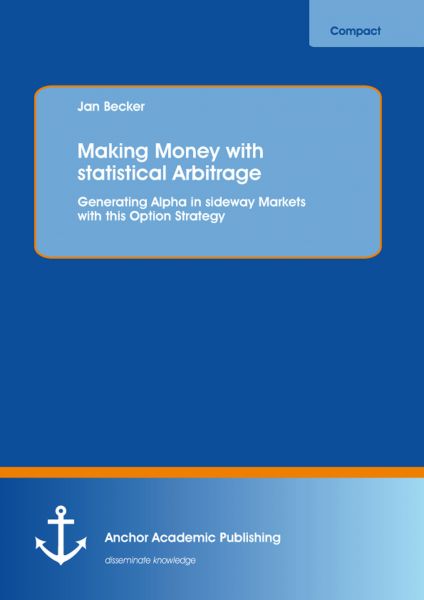Making Money with statistical Arbitrage: Generating Alpha in sideway Markets with this Option Strate
In the following study, I am going to present a short survey of the hedge fund industry, its regulation and the existent hedge fund strategies. Statistical arbitrage in particular is explained in further detail, and major performance measurement ratios are presented. In the second part, I am going to introduce a semi-variance model for statistical arbitrage. The model is compared to the standard Garch model, which is often used in daily option trading, derivate pricing and risk management. As investment returns are not equally distributed over time, sources for statistical arbitrage occur. The semi-variance model takes skewness into account and provides higher returns at lower volatility than the Garch model. The concept is aimed to be a synopsis of mean reversion and chart pattern detection. The computer model is generated with respect to Brownian motion and technical analysis and provides significant returns to the investment. While the market efficiency hypothesis states the impossibility of long-term arbitrage opportunities, market anomalies outstand significantly. Connecting both elements creates a profitable trading system. The combination of both approaches delivers a sensible hedge fund concept. The out-of-sample backtest verifies out-performance and implies the need for further research in the area of higher moment CAPM and additional market timing strategies as sources of statistical arbitrage.
Text Sample:
Chapter 2.1, Overview of the Hedge Fund Industry:
The hedge fund industry has grown from as few as 300 funds in 1990 to more than a $2 trillion industry with 10,000 active funds today. EFAMA (2009) stated that investment fund assets worldwide reached EUR 15.9 trillion at the end of 2009. The very first hedge fund was started by Alfred W. Jones in 1949. By using leverage and short selling, he effectively ,hedged‘ risk in the marketplace. Hedge funds can take both long and short positions, make concentrated investments, use leverage or derivatives, and invest in many markets. This is in sharp contrast to mutual funds, which are highly regulated and cannot easily take advantage the same breadth of investment instruments. Many hedge fund strategies seek to reduce market risk specifically by shorting equities or derivatives. There are a multitude of different strategies used by hedge fund managers today, and the term ,hedge‘ doesn't always apply, since many of these funds are not hedged at all. In fact, many hedge funds take positions that are often highly speculative. Hedge funds are thought to provide returns that are uncorrelated with traditional investments. Their returns over a sustained period of time have outperformed standard equity and bond indexes with less volatility and less risk of loss than equities. Investing in hedge funds tends to be favoured by more sophisticated investors, who understand the private consequences of major stock market corrections. Many endowments and pension funds allocate assets to hedge funds. Most hedge funds are highly specialized, relying on the specific expertise of the manager or management team. Hedge funds are primarily organized as private partnerships to provide maximum flexibility in constructing a portfolio. Most hedge fund managers commit a portion of their wealth to the funds further aligning their interest with that of other investors. Many hedge fund strategies, particularly arbitrage strategies, are limited as to how much capital they can successfully employ before returns diminish. As a result, many successful hedge fund managers limit the amount of capital they will accept. It is important to understand the differences between the various hedge fund strategies. Investment returns, volatility, and risk vary among the different hedge fund strategies. Some strategies are able to deliver consistent returns with extremely low risk of loss, while others may be as or more volatile than mutual funds. The main purpose of hedge funds is to achieve positive returns independently of capital market movements.
Hedge Fund Risks:
Investing in hedge funds implies several forms of risk. The appetite for risk can involve large losses (For example by strategies involving out the money option writing, leverage, short selling or high yield bonds, distressed securities and collateralized debt obligations based on sub-prime mortgages). Not only the known factors of operational and market risks have to be taken into account, but also the risks of transparency and regulation. Additionally to fewer jurisdictions from regulators, there are also less public disclosure requirements.
Fees:
a) The manager's performance fee is calculated as a percentage of the fund's profits, usually counting both realized and unrealized profits. Performance fees align the interests of manager and investor more closely than flat fees do. Typically, hedge funds charge 20% of returns as a performance fee.
B) A high water mark means that the manager receives performance fees only on increases in the net asset value of the fund in excess of the highest net asset value it has previously achieved.
C) Some managers specify a hurdle rate, signifying that they will not charge a performance fee until the fund's annualized performance exceeds a benchmark rate.
The legal structure of a specific hedge fund – in particular ist domicile and the type of legal entity used – is usually determined by the tax environment of the fund’s expected investors. Regulatory considerations will also play a role. Many hedge funds are established in offshore financial centres so that the fund can avoid paying tax on the increase in the value of ist portfolio. An investor will still pay tax on any profit it makes when it realizes ist investment, and the investment manager, usually based in a major financial centre, will pay tax on the fees that it receives for managing the fund.
Around 60% of hedge funds were registered in offshore locations in 2009. The Cayman Islands was the most popular registration location and accounted for 39% of the number of global hedge funds. It was followed by Delaware (US) 27%, British Virgin Islands 7% and Bermuda 5%. Around 5% of global hedge funds are registered in the EU, primarily in Ireland and Luxembourg.
To verify a non-fraud, offshore management companies often provide the latest audited annual and semi-annual report without being obliged to. Moreover the contractual terms and conditions and sales prospectuses or equivalent documents, information on organization, management, investment policy, risk management and custodian bank or a comparable institution and information on investment restrictions, liquidity, the extent of the leverage and the carrying out of short sales are published.
Jan Becker, B. Sc. was born in Germany in 1986. After graduating from the Goethe University in Frankfurt, he enrolled at the Frankfurt School of Finance & Management in 2011. On the side of his Master of Finance program, he is working on tactical asset allocation strategies for a renowned German asset management firm and advises on capital market investments.
Versandkostenfreie Lieferung! (eBook-Download)
Als Sofort-Download verfügbar
- Artikel-Nr.: SW9783954895137
- Artikelnummer SW9783954895137
-
Autor
Jan Becker
- Wasserzeichen ja
- Verlag Anchor Academic Publishing
- Seitenzahl 51
- Veröffentlichung 01.06.2013
- Barrierefreiheit
- ISBN 9783954895137
- Wasserzeichen ja

